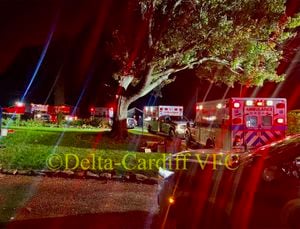On October 11, in Peach Bottom Township, York County, Pennsylvania, a serious incident unfolded when nearly a dozen individuals were hospitalized after consuming toxic mushrooms. The Delta-Cardiff Volunteer Fire Company Station 57 responded to a reported mass casualty event, involving a group of 11 people, including both adults and children, who fell ill after ingesting the mushrooms. The nature of the incident prompted an immediate and coordinated response, showcasing the readiness of local emergency services to handle such medical emergencies.
Responding to the alarming situation, crews from seven different units across three counties promptly mobilized to provide assistance. Upon arrival, medical personnel assessed the affected individuals and determined that they required urgent medical attention. The severity of the situation was evident as all 11 victims were transported to nearby hospitals for treatment, highlighting the potential dangers associated with foraging for wild mushrooms and the risks of misidentifying toxic varieties.
This unfortunate incident serves as a stark reminder of the significant health risks linked to the consumption of wild mushrooms, which can often be deadly if misidentified. Many mushrooms have toxic counterparts that can be fatal or cause severe gastrointestinal distress. The lack of proper knowledge and awareness regarding mushroom foraging can lead to catastrophic consequences, as seen in this situation. It underscores the importance of education and caution among individuals who engage in foraging, whether for recreational purposes or culinary interests.
In light of this incident, health officials are likely to reiterate guidance on mushroom foraging and the inherent risks involved. Such advisories often emphasize the necessity for proper identification, as well as the need for individuals to consult experts or guidebooks before consuming any wild mushrooms. In addition, reminders about the symptoms associated with mushroom poisoning are crucial, as swift medical intervention can significantly improve outcomes for those affected.
While this incident has drawn attention to the dangers of toxic mushrooms, it is also part of a broader conversation regarding public safety and community health. Educating the public about the potential risks and ensuring that resources are available for those interested in foraging can help reduce the occurrences of such incidents in the future. Local health departments and community organizations may consider workshops and informational campaigns to raise awareness and promote safe practices in wild mushroom identification.
In conclusion, the mass hospitalization event in Pennsylvania due to toxic mushroom consumption should serve as a catalyst for increased awareness and education on the topic. As emergency services responded swiftly to the crisis, the hope is that this incident will lead to more robust community efforts aimed at preventing future occurrences. By fostering an informed public, the risks associated with foraging can be mitigated, ensuring safer practices for those seeking to explore the natural bounty that surrounds them.

